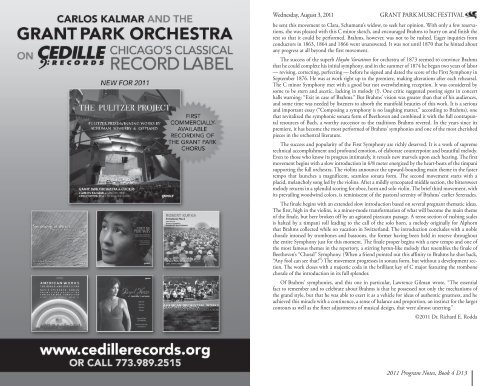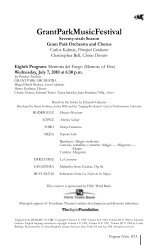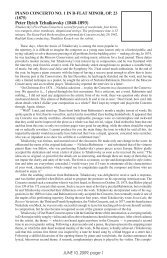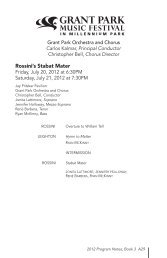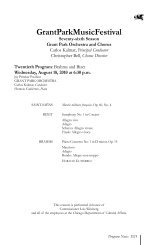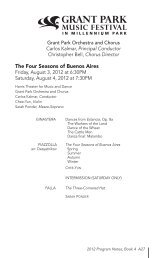Program Notes PDF - The Grant Park Music Festival
Program Notes PDF - The Grant Park Music Festival
Program Notes PDF - The Grant Park Music Festival
Create successful ePaper yourself
Turn your PDF publications into a flip-book with our unique Google optimized e-Paper software.
Wednesday, August 3, 2011<br />
GRANT PARK MUSIC FESTIVAL<br />
he sent this movement to Clara, Schumann’s widow, to seek her opinion. With only a few reservations,<br />
she was pleased with this C minor sketch, and encouraged Brahms to hurry on and finish the<br />
rest so that it could be performed. Brahms, however, was not to be rushed. Eager inquiries from<br />
conductors in 1863, 1864 and 1866 went unanswered. It was not until 1870 that he hinted about<br />
any progress at all beyond the first movement.<br />
<strong>The</strong> success of the superb Haydn Variations for orchestra of 1873 seemed to convince Brahms<br />
that he could complete his initial symphony, and in the summer of 1874 he began two years of labor<br />
— revising, correcting, perfecting — before he signed and dated the score of the First Symphony in<br />
September 1876. He was at work right up to the premiere, making alterations after each rehearsal.<br />
<strong>The</strong> C minor Symphony met with a good but not overwhelming reception. It was considered by<br />
some to be stern and ascetic, lacking in melody (!). One critic suggested posting signs in concert<br />
halls warning: “Exit in case of Brahms.” But Brahms’ vision was greater than that of his audiences,<br />
and some time was needed by listeners to absorb the manifold beauties of this work. It is a serious<br />
and important essay (“Composing a symphony is no laughing matter,” according to Brahms), one<br />
that revitalized the symphonic sonata form of Beethoven and combined it with the full contrapuntal<br />
resources of Bach, a worthy successor to the traditions Brahms revered. In the years since its<br />
premiere, it has become the most performed of Brahms’ symphonies and one of the most cherished<br />
pieces in the orchestral literature.<br />
<strong>The</strong> success and popularity of the First Symphony are richly deserved. It is a work of supreme<br />
technical accomplishment and profound emotion, of elaborate counterpoint and beautiful melody.<br />
Even to those who know its progress intimately, it reveals new marvels upon each hearing. <strong>The</strong> first<br />
movement begins with a slow introduction in 6/8 meter energized by the heart-beats of the timpani<br />
supporting the full orchestra. <strong>The</strong> violins announce the upward-bounding main theme in the faster<br />
tempo that launches a magnificent, seamless sonata form. <strong>The</strong> second movement starts with a<br />
placid, melancholy song led by the violins. After a mildly syncopated middle section, the bittersweet<br />
melody returns in a splendid scoring for oboe, horn and solo violin. <strong>The</strong> brief third movement, with<br />
its prevailing woodwind colors, is reminiscent of the pastoral serenity of Brahms’ earlier Serenades.<br />
<strong>The</strong> finale begins with an extended slow introduction based on several pregnant thematic ideas.<br />
<strong>The</strong> first, high in the violins, is a minor-mode transformation of what will become the main theme<br />
of the finale, but here broken off by an agitated pizzicato passage. A tense section of rushing scales<br />
is halted by a timpani roll leading to the call of the solo horn, a melody originally for Alphorn<br />
that Brahms collected while on vacation in Switzerland. <strong>The</strong> introduction concludes with a noble<br />
chorale intoned by trombones and bassoons, the former having been held in reserve throughout<br />
the entire Symphony just for this moment. <strong>The</strong> finale proper begins with a new tempo and one of<br />
the most famous themes in the repertory, a stirring hymn-like melody that resembles the finale of<br />
Beethoven’s “Choral” Symphony. (When a friend pointed out this affinity to Brahms he shot back,<br />
“Any fool can see that!”) <strong>The</strong> movement progresses in sonata form, but without a development section.<br />
<strong>The</strong> work closes with a majestic coda in the brilliant key of C major featuring the trombone<br />
chorale of the introduction in its full splendor.<br />
Of Brahms’ symphonies, and this one in particular, Lawrence Gilman wrote, “<strong>The</strong> essential<br />
fact to remember and to celebrate about Brahms is that he possessed not only the mechanisms of<br />
the grand style, but that he was able to exert it as a vehicle for ideas of authentic greatness, and he<br />
achieved this miracle with a continence, a sense of balance and proportion, an instinct for the larger<br />
contours as well as the finer adjustments of musical design, that were almost unerring.”<br />
©2011 Dr. Richard E. Rodda<br />
2011 <strong>Program</strong> <strong>Notes</strong>, Book 4 D13


